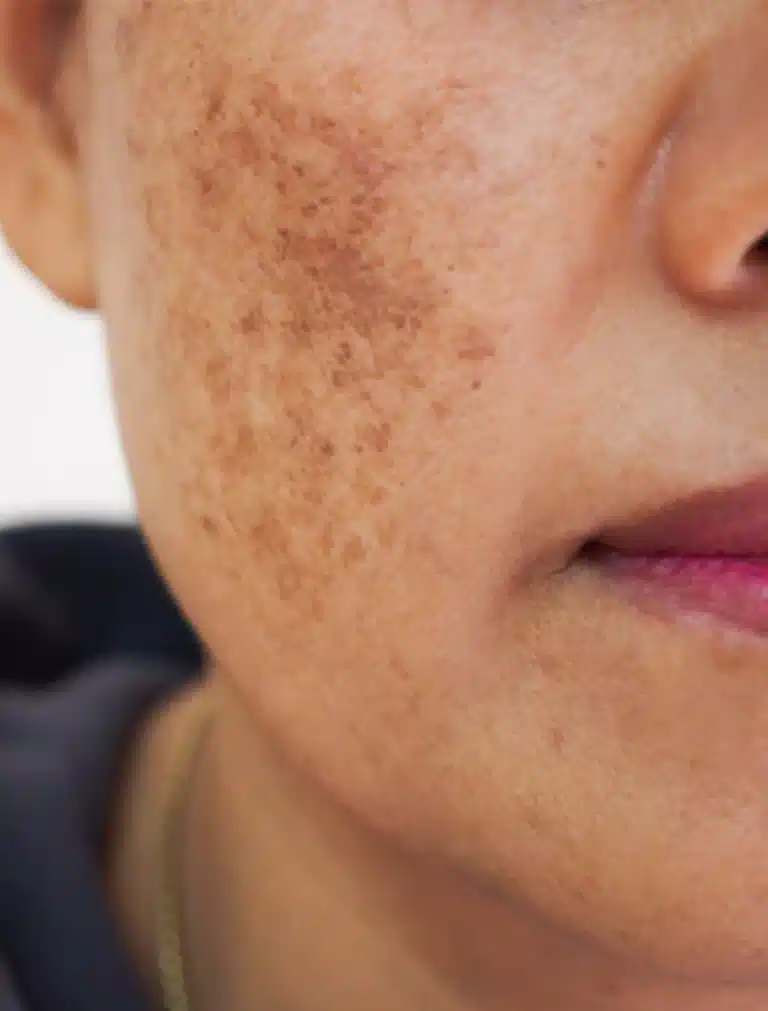What is Melasma?

Melasma is a skin condition that is characterized with the appearance of blotchy brown or grey-blue patches and spots seen on the face, neck and arms. It is most commonly seen in women with a naturally darker skin tone between the ages of 20-40. While melasma is not harmful, studies have shown it can lead to both psychological problems and poor quality of life.
WHAT ARE THE CAUSES OF MELASMA?
Melasma is a skin discoloration condition resulting from the overproduction of melanin in the skin. Melanin is the skins natural pigment and is present both superficially and deeply. Melasma can appear both superficially in the epidermis and/or deeply in the dermis of the skin.We do not know the exact causes of melasma; however, there is a genetic and hormonal predisposition. Melasma is known as the ‘mask of pregnancy’ because hormonal changes caused by pregnancy, as well as hormonal medications (oral contraceptive pill, HRT) can trigger melasma. Thyroid disorders may also have an association with melasma. Ultraviolet exposure is the most significant contributor to melasma. Heat is a trigger for melasma, including sauna, steam, hot sports, or even the fire place should be considered. HOW TO PROTECT SKIN FROM MELASMA Melasma can not be fully prevented in those with a predisposition. It is common for melasma to recur and therefore protecting the skin from UV exposure with a high SPF sunscreen is the cornerstone to prevention. Avoiding direct sun exposure during peak hours, diligent use of high SPF sunscreens and avoiding hormonal medications are important factors to consider. Avoiding heat, like sauna, steam, hot yoga also helps to reduce the risk for melasma. TREATMENTS FOR MELASMACurrently there is no cure of melasma. Treatments and medications available to manage Melasma may result in an incomplete response and relapses are common. Using appropriate treatment can help achieve goals and maintain them with fewer relapses. Most of these therapies can NOT be used while pregnant or breast feeding.Treatment begins with sun protection and topical skin formulations. The most commonly used treatments for melasma are skin lightening medications applied topically. Over the counter ingredients that can help lighten skin include Arbutin, Azaleic Acid, Gluthione, Kojic Acid, Mandelic Acid, Niacinamide, Retinol, Tranexamic Acid and Vitamin C.Topical lightening treatments help by reducing pigment production and inflammation and by reducing excess blood vessels in the skin that contribute to melasma. The gold standard prescription formulation includes a triple combination treatment combining a retinoid, hydroquinone and a low dose topical steroid. Because the actives increase cell turnover, there can be some initial irritation . It is useful to start with a smaller amount every other day until skin acclimates. The duration of this treatment can be discussed to optimize efficacy and minimize risks.In office, a number of treatments can be done.A course of microneedling in conjunction with tranexamic acid can help improve epidermal melasma by creating a small micro-injury that triggers the bodys own healing process. Tranexamic acid helps to lighten and even skin tone. It can also be taken orally for a limited amount of time to improve melasma alone or in combination with other treatments.Dermamelan is a highly effective chemical peel to treat melasma. Dermamelan is safe on all skin types and functions to remove a layer of skin containing excess pigment while also suppressing the production of pigment in the deeper layers. There is some downtime with this peel, including 7-14 days of redness, peeling and swelling. There is a high safety profile and success rate with Dermamelan, particularly with epidermal melasma. The peel is painless.Laser and light treatments can be used with pre and post treatment protocols to help prevent worsening of pigmentation or rebound pigmentation. MOXI is a new fractional, non ablative diode laser treatment that gently helps remove pigment from skin with little downtime.Most importantly, treatments can help fade discoloration but it is common for melasma to return when one spends time outdoors. The best time of year to address melasma is after the summer season to avoid direct and intense ultraviolet exposure.
Testimonials
Trustindex rating score: 4.7 of 5, based on 222 reviews
Book Consultation
As a leading Oculoplastic Surgeon with special interest in Facial Aesthetics, Dr. Maryam Zamani has garnered a global reputation - both in the US and UK - for her meticulous attention to detail and sought-after techniques for eyes and facial aesthetics.
Find The Clinic by Dr Maryam Zamani in the heart of Chelsea
Located on the Kings Road, our clinic is easy to reach from Chelsea, Kensington, Belgravia, Knightsbridge, South Kensington, Fulham and Battersea. We are positioned just moments from Sloane Square with excellent transport links across Central and South West London.
Book Now.avif)



